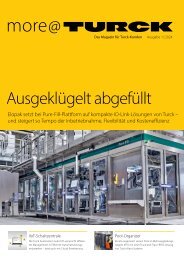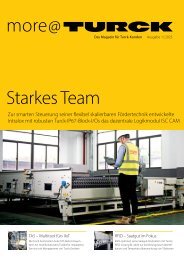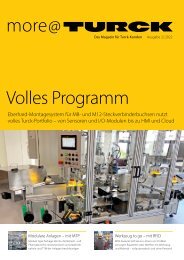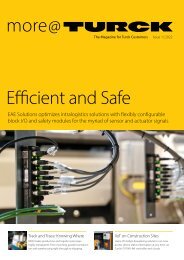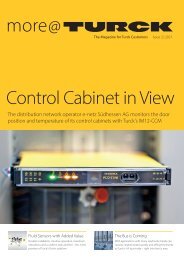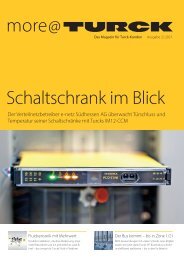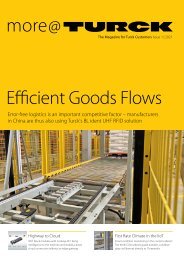more@TURCK 1_23 EN
The Magazine for Turck Customers
The Magazine for Turck Customers
Create successful ePaper yourself
Turn your PDF publications into a flip-book with our unique Google optimized e-Paper software.
<strong>more@TURCK</strong> 1 | 20<strong>23</strong><br />
30 | 31<br />
Thanks to Turck’s HF bus mode, the HF read/write device can be connected very easily to each shelf rack using T pieces, thus<br />
considerably reducing wiring effort and costs<br />
database information. “This is the perfect solution for<br />
us,” says Dr. Joris van Dort, technical innovations<br />
manager at KWS. “The measured values are transmitted<br />
wirelessly and the storage boxes are identified<br />
without contact.”<br />
Fast commissioning thanks to HF bus mode<br />
A key requirement for the new system was the avoidance<br />
of the complex geometry of the old solution<br />
and its large cabling and wiring overhead. Turck’s RFID<br />
interfaces stand out here with a feature that is unique<br />
in the market: HF bus mode. This function allows the<br />
connection of up to 32 HF write readers per port. In<br />
applications with many write and/or read positions,<br />
this considerably reduces the wiring effort as well as<br />
costs. Temperature values and IDs are read cyclically.<br />
This makes it possible to implement continuous<br />
temperature monitoring. The read values can also<br />
be assigned to the containers at any time. “The fact<br />
that the Turck solution uses HF bus mode suited our<br />
requirements perfectly,” said Christian Fricke. “This<br />
enabled us to install the RFID read/write devices for<br />
a rack without any major effort and we just had to<br />
connect the pre-assembled cables with T pieces.”<br />
Benefits of automatic addressing<br />
The automatic addressing of the RFID read/write<br />
devices proved to be a major benefit of the Turck<br />
solution both for commissioning and for service<br />
operations. After connecting with the T pieces, the<br />
devices are automatically assigned addresses which<br />
were activated in the web server. If a device is faulty<br />
and has to be replaced, the TB<strong>EN</strong> registers which read/<br />
write device is missing when it is removed. If a new<br />
module is connected, it is automatically assigned the<br />
address of its predecessor. It is no longer necessary to<br />
store preconfigured replacement devices or carry out<br />
any time consuming addressing of replacements for<br />
service tasks.<br />
Author | Thorsten Enthöfer is product manager for<br />
RFID HF systems<br />
User | www.kws.com<br />
Web code | more1<strong>23</strong>53e





